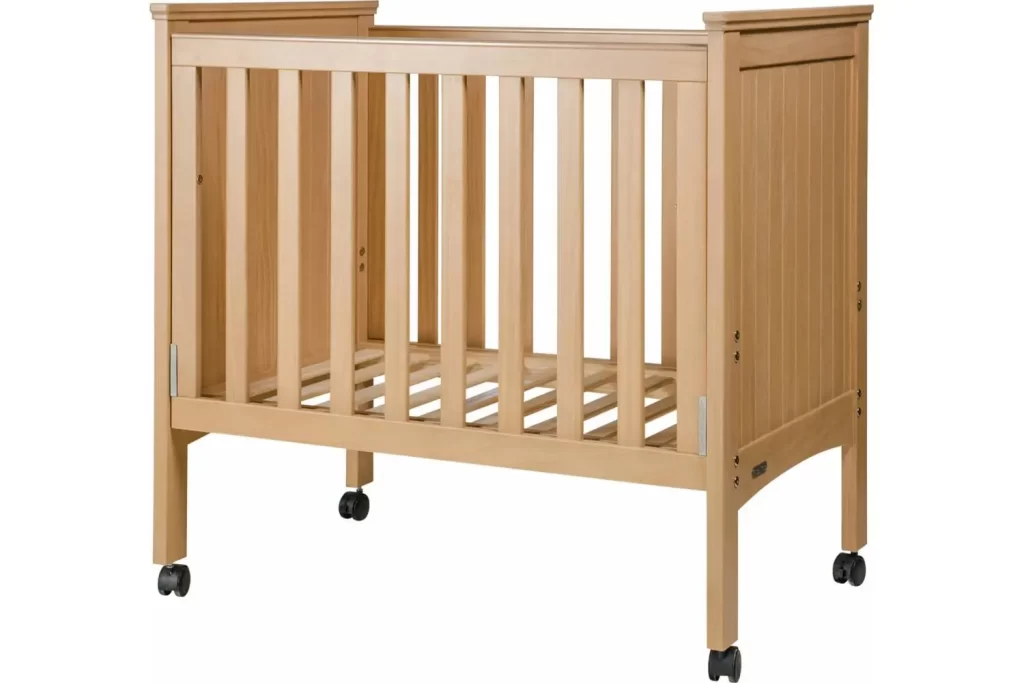How to Choose a Safe Crib for Your Baby

Selecting a crib for your newborn baby is one of the most important purchases you’ll make as a new parent. The crib will be where your little one sleeps for the first few years of life, so it’s crucial to choose one that prioritizes safety and comfort.
This article will cover what features to look for when shopping for a crib, general crib safety tips, and frequently asked questions to help you pick out the best crib for your child.
What Should I Look For When Buying a Crib for My Baby?
When evaluating different crib options, keep an eye out for these key safety features:
No drop-down sides

Cribs with sides that lower or drop down greatly increase the risk of suffocation and strangulation. The American Academy of Pediatrics recommends against using cribs that have moveable sides. Opt for a crib with stationary sides that don’t slide up and down.
Narrow spacing between slats

For safety, the slats on crib sides should be no more than 2 3/8 inches apart. This prevents your baby’s body from fitting through the slats and getting stuck. Measure the space between slats on any crib you consider to ensure ample spacing.
No decorative cutouts or knobs
Cribs should have a simple, basic design without any decorative cutouts or knobs on the headboard or footboard. Protruding decor provides a potential choking or strangulation hazard for curious babies.
Snug fitting mattress
Make sure to get a mattress that fits tightly against the sides of the crib. You should not be able to squeeze more than two fingers between the edge of the mattress and the crib side. Too much space raises the risk of entrapment and suffocation.
General Crib Safety Tips
In addition to looking for these essential crib features, follow these tips for safely using your baby’s crib:
- Always keep the crib free of pillows, blankets, stuffed animals, and other soft bedding. These pose a suffocation risk. Use a wearable blanket or sleep sack to keep your baby warm instead.
- Do not place cribs next to windows or drapes. Keep all cords, blinds, and curtains well out of reach.
- Set the mattress height to the lowest level as soon as your baby can sit up. Once standing, lower it further to prevent falls over the railing.
- Ensure the crib sheet fits tightly and does not bunch up. Ill-fitting sheets create suffocation hazards.
- Do not attach string lights or mobiles with loose parts to the crib or overhead. Opt for musical/projection mobiles well out of reach.
- Routinely inspect the crib for loose screws, splinters, chipped paint, and other defects. Discontinue use immediately if issues arise.
- Verify that the crib model has not been recalled for safety issues. Check the Consumer Product Safety Commission’s website for recalls.
- When converting to a toddler bed, use guardrails, and do not allow the use of the crib if any parts are missing or broken.
Final Thoughts
Choosing the right crib for your baby is a big decision that can impact their safety and quality of sleep in the early years. Be sure to carefully inspect any crib for critical safety features like stationary sides, narrow slats, a tight mattress fit, and lack of protruding decor. Follow safety guidelines diligently and check for recalls. Investing in a high-quality, reliable crib will provide your child with a sound sleep space from infancy into toddlerhood. Do your research to find the perfect crib to help your little one sleep safely and comfortably.
Also Read:
- Are Iron Cribs Safe for Babies
- How to Make an Old Crib Safe for Your Baby
- Why Should Crib Be Away From the Wall
- Does a Crib Come With a Mattress
- Best Crib Alternatives for Your Baby
- 100 Baby Girl Names You Will Love
FAQs
How do I make sure my baby is safe in a crib?
To ensure your baby’s safety while sleeping in a crib, follow these tips: select a crib with fixed sides and narrow slats; use a snugly fitting crib mattress; avoid all soft bedding, bumpers, and loose items; check regularly for design flaws and damage; refer to manufacturer instructions; and lower mattress height as baby grows.
What should parents look for when selecting a crib?
The key safety features to look for in a crib include stationary drop sides that do not slide up and down, slats no more than 2 3/8 inches apart, a simple design without decorative cutouts, and a mattress that fits tightly against the sides with no major gaps. Also verify the crib is not on any recall lists.
Should cribs have slats on all sides?
Yes, proper cribs should have slats on all four sides. The slats allow for ventilation to prevent overheating while also permitting parents to see into the crib to check on their baby. Just be sure the slats are narrowly spaced (no more than 2 3/8 inches apart) for safety.
What qualifies as a safe crib?
A safe crib has fixed, non-drop sides, a close slat spacing of under 2 3/8 inches, and a snug mattress fit with no more than two finger widths’ gap.
It should also be free of cutout decorations, loose knobs, or dangling strings that may pose choking, strangulation, or entrapment hazards to babies.
For how long can I use a crib?
It is generally recommended to transition your child out of a crib between ages 2 and 3. Many convert to toddler beds around age 2. Use the lowest mattress height once your child can stand and climb out of the crib to prevent dangerous falls. Discontinue crib use if your child is climbing out unaided or exceeds the crib’s height or weight limits set by the manufacturer.
Can newborns sleep in a crib right away?
Yes, it is safe for newborns to sleep in a crib from day one, as long as safety guidelines are followed. Make sure the mattress is completely flat and free of pillows, quilts, and stuffed animals. Swaddle your newborn or use a wearable blanket for warmth instead of loose bedding. Lower the mattress level and gradually transition from a bassinet as your baby grows.
